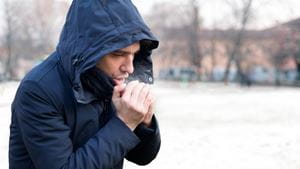
The winter months in New York can get very cold – sometimes dangerously so. In February 1979, the Adirondack town of Old Forge set an all-time low record temperature for the state at -52°F.
While a new record low temperature does not appear to be in store so far this winter, people who are outside or lacking heat in single-digit or subzero temperatures are at risk for frostbite and hypothermia if they stay out too long without proper winter apparel.
Ryan Buryta, DO, is the Associate Medical Director of Adult Emergency at Rochester General Hospital, and treats patients with hypothermia and frostbite. He explains the differences in symptoms, diagnosis, and treatments for both conditions.
Frostbite is an injury that happens to the skin when it is exposed to extreme cold temperatures. The skin freezes, causing a loss of feeling and color.
Areas of the skin that are typically exposed to the winter elements include the cheeks, nose, chin, fingers, and toes.
The initial signs of frostbite are numbness and skin that starts to feel more firm or waxy. If the skin begins to turn white or a gray/yellow color, frostbite may be setting in.
According to the CDC, a person with frostbite may not be able to feel their own skin because their sense of touch is dulled by the extreme cold temperatures.
“It’s important to know the initial symptoms of frostbite because it is reversible,” Dr. Buryta said. “If someone is having early signs of frostbite, this is initially reversible. When the symptoms become more severe, the effects become irreversible.”
To counteract the symptoms of frostbite, head indoors to a warm area as quickly as possible. Avoid walking on feet or toes that may have frostbite; do not massage any affected skin, either. Additional pressure can further damage the affected part of the body.
Putting the affected area in warm water can help to restore circulation without damaging the skin. Contact a healthcare provider as soon as possible to seek medical care.
Avoid warming the skin too quickly with a heat source such as a heating pad, heat lamp, stove or fireplace. This might cause burning.
Hypothermia is a life-threatening condition that happens when a person’s core body temperature becomes abnormally cold due to exposure to extreme cold.
The longer a person is exposed to extreme cold temperatures, the longer their body loses the heat it produces. People who are older and lack adequate shelter, food, or clothes are at risk of hypothermia, along with babies sleeping in cold rooms and people drinking alcohol or using illicit drugs, according to the CDC.
Children and adults show signs of hypothermia differently.
Children will have bright red skin that feels cold and act lethargic, while adults will begin to act confused, slur their speech and become drowsy or lethargic. Intense shivering is often an early warning sign of hypothermia.
The first thing a person should do if they are exhibiting signs of hypothermia is to head indoors, if they are not already. Once inside, they can remove all damp clothing, put in dry clothing, and wrap themselves in dry blankets or sheets.
If a person has severe hypothermia, they may be unconscious or fade in and out of consciousness.
“Hypothermia has the potential to be a life-threatening condition,” Dr. Buryta said. “If a person is showing any of the symptoms of hypothermia, call 911 for professional medical attention as quickly as possible.”